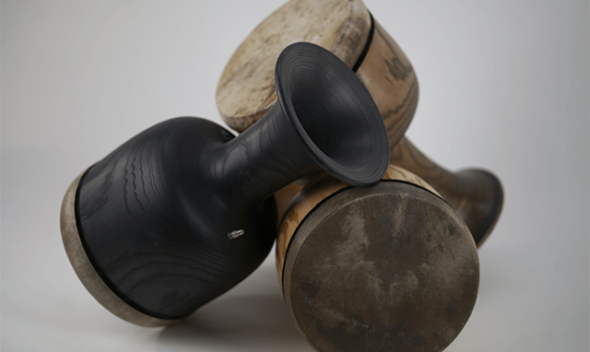For centuries, the riqq has been one of the most important frame drums in Middle Eastern music. Its shimmering jingles and expressive tones have accompanied orchestras, soloists, and dancers alike. Today, the riqq is not only a traditional instrument but also an essential tool for professional percussionists, fusion artists, and ambitious students worldwide.
In this guide, we will explore the history, techniques, construction, and modern innovations of the riqq. Whether you are completely new to the instrument or already an experienced musician, this article will give you a comprehensive overview – and point you to resources for learning, practicing, and purchasing your own riqq.
What is a Riqq?
The riqq (also spelled riq or rik) is a small frame drum traditionally played in the Arab and Turkish world. At first glance, it resembles a tambourine, but its role and sound are far more complex.
-
Size: Typically around 22–24 cm (9–10 inches) in diameter.
-
Materials: Wooden frame, goat or fish skin (modern models also use synthetic heads).
-
Jingles: Brass or bronze cymbals mounted inside the frame.
Unlike the Western tambourine, the riqq is a soloistic percussion instrument capable of subtle rolls, sharp snaps, and complex rhythmic phrases that form the heartbeat of ensembles.
Curious about the differences? Check out our article: [Riqq vs. Daf vs. Tambourine – What’s the Difference?]
A Brief History of the Riqq
The riqq has roots that reach back to the 8th–9th century, when it became central to Arabic classical music ensembles (takht). It provided the rhythmic foundation for instruments like the oud, qanun, and ney.
Through Ottoman culture, the riqq also spread into Turkish classical music. Its adaptability allowed it to cross borders and centuries, becoming a key part of weddings, ceremonies, and concerts.
-
Medieval period: The riqq was considered a noble instrument, often played in courts.
-
20th century: Riqq masters like Mohamed El Arabi or Michel Merhej established the modern technique that many players study today.
-
Today: The riqq is found not only in Arabic and Turkish ensembles but also in jazz, fusion, and world music.
Construction & Materials
A handcrafted riqq is a piece of art. Its main elements are the following:
-
Frame: Usually made of high-quality hardwoods (walnut, mahogany, maple) for durability and resonance.
-
Skin: Traditionally goat or fish skin, giving warmth and depth. Modern riqqs may use synthetic heads for stability across climates.
-
Jingles (zills): Thick, heavy cymbals mounted in pairs, giving a bright, cutting shimmer.
At Majid Drums, every riqq is handcrafted with careful woodworking and acoustic precision – ensuring not only playability but also a deep connection to tradition.
Planning to buy your own instrument? Read our detailed guide: Which Riqq Should I Buy? A Buyer’s Guide for Students & Professionals
Playing Techniques
The riqq is one of the most challenging frame drums to master. Its versatility allows for both powerful projection and delicate textures.
The Basic Sounds
-
Dum: Deep bass stroke in the center of the head.
-
Tak / Ka: Sharp edge tones with left or right hand.
-
Snaps: Finger flicks on the head, producing crisp accents.
-
Rolls: Continuous sound using rapid finger movements.
Rhythms
Traditional Arabic music uses iqa‘at (rhythmic cycles). Examples include:
-
Maqsum (4/4)
-
Saidi (4/4)
-
Malfuf (2/4)
Mastering these requires control of dynamics and coordination between head and jingles.
Want to learn step by step? Take a look at our tutorial article: How to Play the Riqq – Beginner’s Guide
The Role of the Riqq in Ensembles
In an Arabic takht, the riqq is the timekeeper and colorist:
-
Keeps tempo: Locking the ensemble together.
-
Shapes dynamics: Switching between soft textures and loud accents.
-
Leads transitions: Signaling changes in rhythm or intensity.
This makes the riqq not just a background instrument, but often the conductor of rhythm.
The Riqq Today – From Tradition to Innovation
While rooted in tradition, the riqq has found a place in many modern contexts:
-
Fusion & Jazz: Used by percussionists to bring Middle Eastern textures into global music.
-
Film & Soundtracks: Adds authenticity to cinematic scores.
-
Solo Performances: Virtuoso riqq players turn rhythm into melody.
But with modern needs comes a modern problem: practicing quietly.
The Silent Riqq – A Gamechanger for Practice
One of the biggest challenges for riqq players is noise. The jingles are loud, making it hard to practice at home, on tour, or late at night.
This is why Majid Drums developed the Silent Riqq – a handcrafted innovation that keeps the authentic size and feel of a professional riqq, but drastically reduces the volume.
-
Authentic playing experience – same ergonomics as a concert riqq.
-
Quiet practice – muted jingles allow training without disturbing others.
-
Travel-friendly – lightweight and durable, perfect for hotel rooms or backstage.
Read more in our dedicated feature: Silent Practice for Drummers – Why the Silent Riqq Changes Everything
Why Handcrafted Matters
Not all riqqs are created equal. A factory-made riqq may look similar, but lacks the fine-tuned balance of head tension, frame resonance, and jingles that make the instrument truly sing.
At Majid Drums, each riqq is hand-built with attention to detail. This ensures:
-
Consistent tone across all strokes.
-
Ergonomic comfort for long playing sessions.
-
Aesthetic beauty that matches the sound.
Learn more about our process in the upcoming article: Handcrafted Percussion – Why Artisan Instruments Make a Difference
Conclusion
The riqq is more than just a frame drum. It is a rhythmic voice with centuries of tradition, a conductor of ensembles, and now, through innovations like the Silent Riqq, a tool adapted for modern musicians’ needs.
Whether you are a professional percussionist, an ambitious hobbyist, or a music student, the riqq offers endless possibilities for expression and growth.
Ready to take the next step?
-
Explore the Majid Drums Shop for handcrafted riqqs and the Silent Riqq.
-
Join the WhatsApp waiting list and talk directly to Majid: Message here.
Your rhythm journey begins with the riqq. Don’t just practice music – live it.



Leave a comment